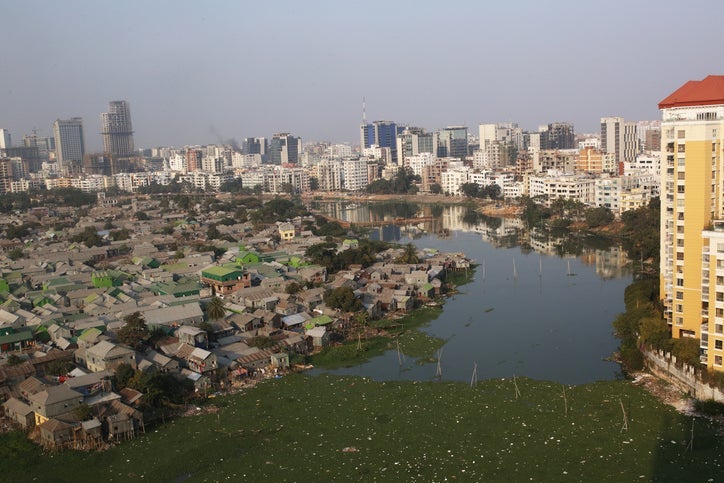
COP28 saw progress on global adaptation efforts, with governments agreeing on targets for a Global Goal on Adaptation (GGA) and an accompanying “framework” to guide national efforts towards building resilience against the impacts of climate change. Despite this progress, however, global investment in adaptation is sorely lacking. While adaptation finance reached an all-time high of $63bn in 2021/2022, growing 28% from 2019/2020, this still falls far short of the estimated $212bn per year needed by 2030 for developing countries alone, according to a recent report from the non-profit Climate Policy Initiative. The $63bn figure represents just 10.4% of total public climate finance, with $536bn directed towards mitigation.
When it comes to private capital, the gap is even starker, with flows towards adaptation representing just 0.24% of the total – $1.5bn, compared with $614bn for mitigation.

Access deeper industry intelligence
Experience unmatched clarity with a single platform that combines unique data, AI, and human expertise.
There is a “pressing need for international providers to significantly scale up their efforts” to leverage private sector investment for adaptation, finds a November 2023 report from the OECD. It notes that the impact of climate change is most felt in developing countries, which are "already dealing with a multitude of challenges ranging from economic disparities to developmental goals, [and] now face an augmented threat from unpredictable sea levels, changing weather patterns, and compromised natural resources".
Analysts underscore the wide-ranging financial losses risked by a failure to adapt: under a ‘slow transition’ scenario without adaptation, roughly 12% of South Asia’s gross domestic product (GDP) could be lost annually by 2050 – more than three times the world average. Sub-Saharan Africa and the Middle East and North Africa would see roughly 8% of GDP at risk, while Europe and North America tend to be less exposed with about 2% of GDP at risk. Water stress and extreme heat are expected to be among the top contributing factors to adaptation losses.

US Tariffs are shifting - will you react or anticipate?
Don’t let policy changes catch you off guard. Stay proactive with real-time data and expert analysis.
By GlobalDataPrivate finance for adaptation: locating the opportunities
One "obvious investment barrier" when it comes to adaptation finance is a "general lack of knowledge" in the private sector about what these projects are, according to a December 2023 technical document on scaling up blended finance for adaptation and mitigation from the Network for Greening the Financial System (NGFS), a network of 114 central banks and financial supervisors.
For Ravi Chidambaram, co-founder of Pan-Asian investment bank TC Capital, the opportunities in adaptation are clear, and severely overlooked. Speaking to Energy Monitor, Chidambaram lists investable assets that span a spectrum of needs, including flood and wildfire prevention, resilient agriculture, clean water supply, infrastructure modification and population resettlement.
Opportunities lie across the “three phases of climate adaptation”, he says: disaster prevention (assets include warning systems, satellites); management (training corporates on dealing with climate emergencies, emergency food provisions); and recovery (for example, modular construction, smart agriculture).
In a 2022 article published in the Harvard Business Review, co-authored by Chidambaram, the authors note that such adaptation-linked assets "deserve far greater business investment, especially because they represent near-term opportunities at lower capital expenditures that offer faster paybacks”. Unlike “blue sky technologies” like carbon sequestration or nuclear fusion, which “won’t, in reality, be [deployed] on a mass scale until 2050”, financial payback on many adaptation innovation technologies is far quicker, Chidambaram says.
However currently, “very little [adaptation finance] is coming from institutional capital”, he notes. This doesn’t have to be the case, he argues – although many adaptation solutions, like forest fire detection technologies, are “tech IP solutions” and therefore only relevant to early-stage investors, there are opportunities for institutional investors in more mature companies. For example, engineering companies building earthquake-resilient buildings and conglomerates taking steps to adapt to climate impacts.
Indeed, while opportunities for adaptation finance are often thought of as relating to physical assets that protect against climate risks, like flood barriers or early warning systems, “continuous adaptation is an inherent feature of the private sector and a core function of the market” and relates not just to climate change but also to changing consumer needs and preferences, argues analysis from the LSE Grantham Institute.
In this sense, adaptation can be thought of as a "function of business optimisation in response to changing external circumstances, and it is driven by the profit motive". Empirical research shows that climate change has a significant positive impact on the innovation strategies of small and medium-sized enterprises in developing countries.
This is a concept echoed by Eric Usher, head of the UN Environment Programme’s Finance Initiative, who says that while channelling private finance towards adaptation is “certainly a high priority… a lot of lending decisions do take adaptation into account”. This is part of the value of disclosure standards such as those set out by the Taskforce for Financial Related Disclosures, he adds.
Given that businesses "may not need to tap into dedicated external resources such as adaptation loans or adaptation equity: they might use existing funds from credit lines or retained earnings instead", some adaptation finance flows may not show up in adaptation finance statistics, finds the Grantham Insitute’s analysis.
Drowning in debt
Another means by which private investors can direct capital towards adaptation is through debt financing. However, 93% of countries at the forefront of climate disasters are “drowning in debt”, meaning they present a greater perceived risk and therefore a higher cost of capital for investors.
As such, blended finance solutions "play an important role" in enhancing the investability of climate projects in emerging markets, says the NGFS. A blended finance fund or financing vehicle geared towards adaptation could include sustainability-linked sovereign bonds, or nature-based solutions.
One such initiative is GAIA, a blended finance platform that emerged from a partnership between Japanese financial services provider Mitsubishi UFJ Financial Group (MUFG) and FinDev Canada, Canada's bilateral development finance institution. GAIA is a $1.48bn climate-focused platform that will offer long-term loans for adaptation and mitigation investments in up to 25 developing countries across Asia, Africa, Latin America and the Caribbean. It is “primarily focused on adaptation”, says Lori Kerr, FinDev Canada’s CEO.
“[The fund] brings together commercial finance, concessional finance and philanthropic capital to create something that is new and innovative – we want this to be a blueprint that can be replicated,” she adds. Because it is focused on sub-sovereign borrowers, as opposed to purely the private sector, “we are able to look at a number of different types of models to get some learning around the sort of challenges in terms of revenue generation, and around what we look for in a repayment profile”.
Despite such opportunities, Kerr highlights the importance of a supportive policy environment. “Host country governments cannot be under-emphasised,” she says. “[These] are the entities that create the environment within which the private sector can ideally flourish.”
A COP28 agreement that all countries will revise their National Adaptation Plans (NAPs) is exactly the type of thing that can help mobilise private finance towards adaptation, she notes, much as how nationally determined contributions have helped to leverage finance for mitigation.
Another potential vehicle for private sector investments in adaptation is carbon credits. One proposal put forward by the Alliance of Small Island States last year was a call for a 5% levy on carbon credit revenues for the global Adaptation Fund, which was created under the UN Kyoto Protocol back in 2001. However, the idea was rejected last March by the Integrity Council on the Voluntary Carbon Market, with critics arguing that a levy would add extra costs to carbon offsets and reduce the impact of carbon reduction projects.
The potential use of carbon credits to support adaptation raises a question about equity: is it fair that private investors and businesses in wealthier countries, which are largely responsible for climate change, profit from the problems they have created?
Speaking to Energy Monitor at COP28, Nigerian architect and environmental activist Nnimmo Bassey argued that by looking to offset emissions, rather than cutting them at source, rich countries are “compound[ing] climate injustice”. He applies the same logic to investments in nature-based solutions: “putting a financial value on nature... is not the way forward”. It represents a “colonial arrangement”.
Climate adaptation… for the rich
In his piece in the Harvard Business Review, Chidambaram and his co-author Parag Khana detail the real-estate opportunities in adaptation. Their research suggests that "investing early in climate-resilient geographies will generate more than 70% higher returns on real estate portfolios by 2030 alone".
"Property developers, asset managers, and insurers should take heed, accelerating the acquisition of land, construction of affordable housing, and adjustment of premiums to anticipate, encourage, and profit from climate-induced migrations,” they write.
This is a striking argument, not least because it is “dystopian”, Chidambaram acknowledges. Nonetheless, he says, there are “some very sophisticated institutional asset managers [using] very advanced climate modelling techniques” to predict where disasters could occur, which they use to influence investment decisions. Russia, and parts of Canada, are “viewed as very desirable from a climate resilience perspective”.
Chidabaram concurs that one potential effect of such modelling is a “dystopian scenario where poor and vulnerable people will be trapped in climate disaster prone zones, and people with money will flock to more secure areas – with moral and social consequences that would need to be examined”. This can be thought of as “climate adaptation, for the rich”, he suggests.
In 2011 the UNFCCC released a paper discussing the potential of financing adaptation using a credit trading mechanism. The paper concludes that "as with the case of mitigation, the use of market mechanisms alone to reduce vulnerabilities is insufficient… requiring that polluters pay to reduce vulnerabilities is probably the fairest or most equitable approach". Some progress towards a more equitable approach to financing adaptation materialised on the first day of COP28, when world leaders agreed to a Loss and Damage Fund to help the poorest and most vulnerable countries cope with climate-related impacts.
The funds, which are supposed to come in the form of grants rather than loans, are expected to catalyse private investment, including for adaptation. However, initial contributions to the new fund add up to just over $400m – a far cry from the hundreds of trillions of dollars in climate damages expected in the coming year.
What is clear is that while private investment in adaptation is sorely needed, wealthier nations must urgently and dramatically scale up their public financing towards adaptation in the form of grants, not only as a means of mobilising private finance but also because of their historical responsibility for emissions. The alternative is that adaptation needs are seen only as opportunities to exploit, rather than a collective problem to solve – and that the needed financing is ultimately not forthcoming.







